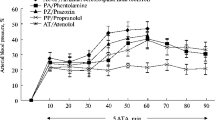Summary
Eserine injected into the anterior chamber of monkeys in deep barbiturate anaesthesia decreases outflow resistance. The effect is obtained even after previous ganglionic block by hexamethonium and is then still counteracted by atropine. This indicates the presence of acetylcholine not released by nervous tone. Systemic hexamethonium itself increases outflow resistance, as does atropine, but atropine has no effect after hexamethonium. This argues against the spontaneous release of appreciable amounts of acetylcholine after ganglionic block. The action of eserine on outflow resistance therefore seems to be dual, to release acetylcholine and not only to protect it.
Résumé
Eserin injecté dans la chambre antérieure de singes anaesthésiés avec des barbiturates diminue la résistance de l'angle camérulaire. Cet effet peut être montré aussi après bloc ganglionaire par hexamethonium et dans ce cas peut être encore supprimé par atropin. Cela montre la présence d'acetylcholine ne pas libéré par le tonus nerveux. Hexamethonium seul appliqué par voie intraveneuse augmente la résistance camérulaire comme atropin, mais atropin après hexamethonium n'a pas d'effet. Ces résultats parlent contre une libération spontanée de quantités appréciables d'acetylcholine après bloc ganglionaire. L'eserin semble donc avoir un effet double sur la résistance camérulaire par la libération d'acetylcholine et par sa protection.
Zusammenfassung
Eserin, in die Vorderkammer von Affen in tiefer Barbituratnarkose injiziert, erniedrigt den Abflußwiderstand. Diese Wirkung tritt auch nach vorherigem Ganglienblock durch Hexamethonium auf und wird dann immer noch durch Atropin aufgehoben. Das bedeutet Anwesenheit von Acetylcholin, das nicht durch nervösen Tonus freigesetzt worden ist. Allgemeine Applikation von Hexamethonium allein erhöht den Abflußwiderstand wie Atropin, aber Atropin hat keine Wirkung nach Hexamethonium. Das spricht gegen eine spontane Abgabe von merklichen Mengen von Acetylcholin nach Ganglienblock. Die Wirkung von Eserin auf den Abflußwiderstand scheint deshalb eine doppelte, nämlich Acetylcholin frei zu machen und nicht nur, es zu schützen.
Similar content being viewed by others
References
Bárány, E. H. The Mode of Action of Pilocarpine on Outflow Resistance in the Eye of a Primate (Cercopithecus ethiops). Invest. Ophthal. 1, 712–727 (1962).
— Glaucoma Research Conference. Amer. J. Ophthal. 56, 470–476 (1963).
— Simultaneous Measurement of Changing Intraocular Pressure and Outflow Facility in the Vervet Monkey by Constant Pressure Infusion. Invest. Ophthal. 3, 135–143 (1964).
árány, e. h. Dissociation of Accommodation Effects from Outflow Effects of Pilocarpine. In: Drug Mechanism in Glaucoma (1965).
— Relative Importance of Autonomic Nervous Tone and Structure as Determinants of Outflow Resistance in Normal Monkey Eyes (Cercopithecus ethiops and Macaca irus). In: II. Symposium Eye Structure, Ed. by J. W. Rohen, Schattauer-Verlag, Stuttgart 1966.
Beaver, W. T. & W. F.Riker. The Quantitative Evaluation of Autonomic Drugs on the Isolated Eye. J. Pharmacol. exp. Ther. 138, 48–56 (1962).
Carlyle, R. F. The Mode of Action of Neostigmine and Physostigmine on the Guinea-pig Trachealis Muscle. Brit. J. Pharmacol. 21, 137–149 (1963).
Author information
Authors and Affiliations
Additional information
This study was supported by Grants NB 3060 and NB 3637 from the Institute of Neurological Diseases and Blindness, United States Public Health Service, Bethesda, Md. The animal facilities at Makerere which made the study in vervets possible were donated by the Wellcome Trust, London.
Department of Physiology, Makerere University College Medical School, Kampala, Uganda.
Rights and permissions
About this article
Cite this article
Bárány, E. Action of eserine, hexamethonium and atropine on outflow resistance of monkey eyes indicating that eserine releases acetylcholine besides protecting it. Doc Ophthalmol 20, 150–156 (1966). https://doi.org/10.1007/BF00165413
Issue Date:
DOI: https://doi.org/10.1007/BF00165413




